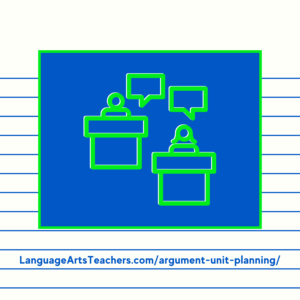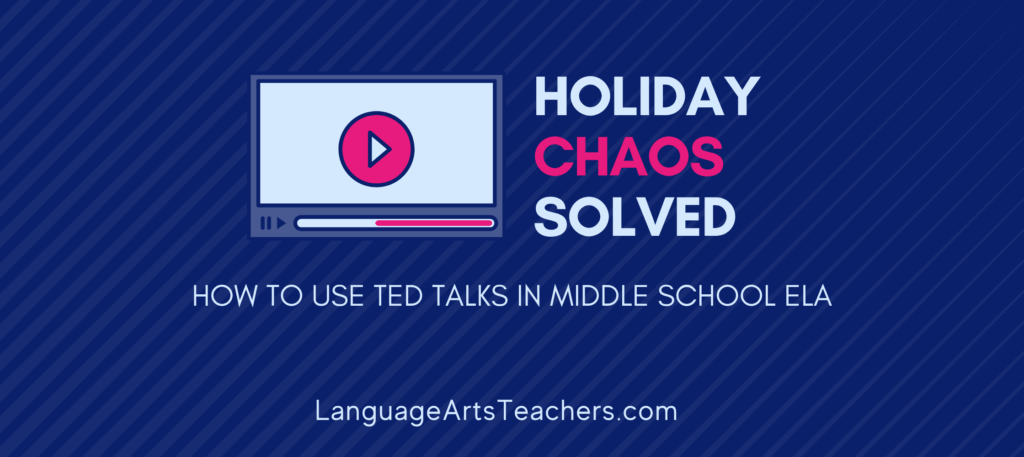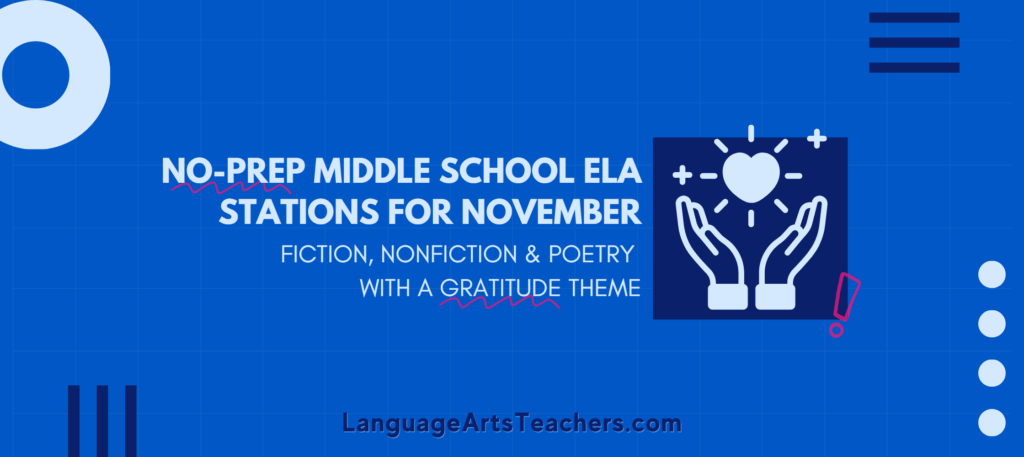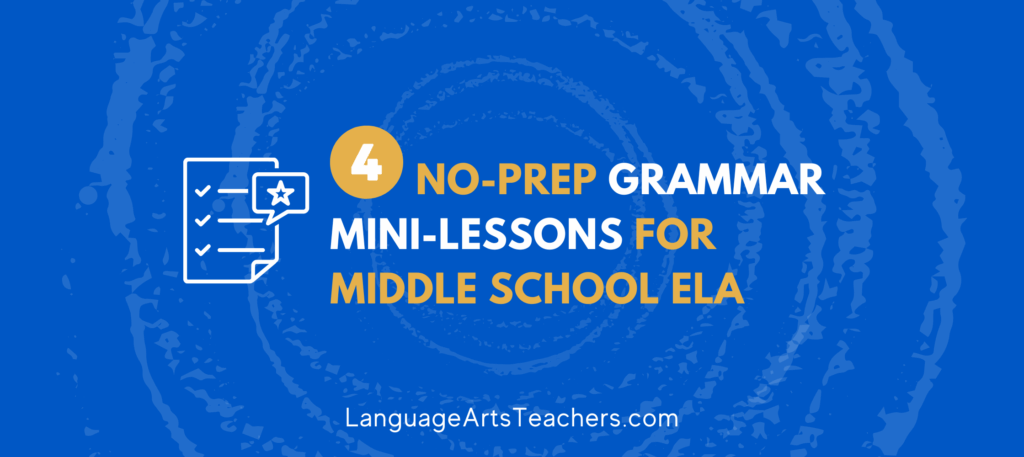With the right preparation, your argument unit can not only be very beneficial for your students, but also a lot of fun to teach. It will all start with an immersive experience that will help your students personally understand the value of a great argument, where they’ll get to learn and practice all the skills that go into being persuasive.
Before your students know it, they will become better at getting their point across and arguing any topic or issue that they may want to defend. It’s a skill that will last them the rest of their lives, and it will be a skill that was planted and watered in your classroom.
So take advantage of these argument unit planning tips and set your students up for success.
Setting up the experience
A great way to start an argument unit is with an immersive experience that your students will remember. Start with a little role play and allow your students to experience arguing and persuasion in a situation that is already very relevant for them. A good example would be playing the role of a kid wanting to convince their parents to buy them the new iPhone that just came out.
In Situation A, the kid doesn’t use any helpful persuasion, but just becomes whiny and continues to say “I want it” or “I need it” without giving any reasoning as to why they need it.
For instance, it might go like this:
Anna: Dad, I really, really need to have a new iPhone.
Dad: No way. You already have an iPhone that you’re using. You don’t need a new one.
Anna: Ugh! But I just want a new one!
Dad: Why do you need a new iPhone when you already have one that works just fine?
Anna: Because everyone at school has a new one and they do all this neat stuff.
In Situation B, the kid uses logical reasons and provides compelling arguments as to why they actually need the new iPhone: how it would benefit the family, or how they would use it for school, etc.
Anna: Dad, I really, really need to have a new iPhone.
Dad: No way. You already have an iPhone that you’re using. You don’t need a new one.
Anna: True, but the processor has become really slow because I’ve been overusing it for school
work. I downloaded so many apps for all my classes that I’m out of space on it. There aren’t
enough gigs for everything I need to do.
Dad: Why don’t you go through your apps and delete the ones you don’t use very much. That’ll free up some space and make the processor run faster.
Anna: That’s a good idea, but I’ve already done that. My problem is that my phone loads them
really slowly. That means I’m sitting in class, falling behind, and you know how I like to be ahead.
A really engaging role play like this allows students to see what a good argument looks like compared to one that is whiny or not well thought out. Moving forward, regardless of the topic you want to debate, students will have an idea of what they should be striving for.
Get the full role play scripts plus questions and answer keys as well as all the strategies and plans you need for Middle School ELA from the 5-day virtual conference I host specifically for 6th, 7th, and 8th Grade Reading & Writing Teachers! It’s the MSELA Summit, and it has 30 hours of on-demand sessions (and PD Certificates!) for you about unit planning, tech tools, classroom management, reading and writing strategies, and more that you can use all year long.
Immersive Role Play Experience
To better help your students understand the difference between the two, have them role play this situation. You can have a specific script (the exact one I give to attendees of the MSELA Summit during my “Argument Planning” session) and allow your students to play both the role of the child and the parent in the two situations. This will better help students fully see the difference between the two types of argument.
As you go on through the unit, you can go back and reference this role play when comparing different arguments that you may watch, read, or listen to, so that students will immediately recognize your reference and be able to apply it as their lessons intensify.
Skills and terminology
After going through the role play portion and having students understand the basic ideas of what a good argument should look like, you now need to teach them some of the different skills and debate terminology. This allows you all to start using the same academic vocabulary as you experience various speeches, debates, and argument analysis.
List of Argumentative Terms
Here are a few terms that you should focus on with your students throughout your argument unit. Better yet, once you’ve completed the first role play described earlier, you can introduce these terms and have students start analyzing how they function in the two role play scenarios.
Claim: In an argument, a claim is a statement that you make in order to support your position. A claim must be something that can be supported by evidence and reasons. It should also be something that is debatable, meaning that people could reasonably disagree with it.
For example, if you are arguing that smoking is harmful to your health, you would need to provide evidence to support your claim. This could include statistics on the number of smokers who develop lung cancer, as well as information on the harmful chemicals found in cigarettes.
Without a claim, an argument is simply a series of assertions or opinions with no clear purpose or direction.
Argument: An argumentative term is a word or phrase that is used to make an assertion or claim. When used in an argument, it is usually intended to persuade the listener or reader to agree with the speaker or writer’s point of view. Argumentative terms can be either positive or negative in nature.
For example, the “argument” in Situation A regarding Anna whining about wanting a new iPhone is simply that “Everyone at school has one . . . And they do all this neat stuff.” It’s a weak, pointless argument because it’s not technically true, and also because it’s based on an opinion.
Ultimately, whether an argumentative term is effective depends on how well it supports the overall argument. However, when used correctly, argumentative terms can be a powerful tool for persuading others to see things from your perspective.
Emotional Appeal: An emotional appeal is a rhetorical device that uses emotion to persuade an audience. Appeals to emotion are often used in advertising and politics. They can be effective, but they can also be manipulative. When used ethically, emotional appeals can help to create an emotional connection between the speaker and the audience. This can make the audience more receptive to the message.
Appeals to emotion can be dangerous when they are used to exploit people’s fears or vulnerabilities. In such cases, they can be used to manipulate people into making decisions that they wouldn’t otherwise make. It is important to be aware of emotional appeals so that you can make informed decisions.
In our Situation A example, Anna uses emotional appeal (though she doesn’t use it very well at all) by stating that “Everyone at school has one . . . And they do all this neat stuff.”
Logical Appeal: A logical appeal is a type of argument that uses reasoning to persuade an audience. This appeal relies on the use of logical statements and valid evidence to support a claim. When making a logical appeal, it is important to be clear and concise in your reasoning. This type of argument is often used in academic settings, as it can be supported by research and data.
Additionally, a logical appeal can be convincing to an audience who may not be familiar with the topic at hand. When used effectively, a logical appeal can be a powerful tool for persuasion.
In our Situation B example, Anna uses logical appeal quite well by stating that the processor in her current phone loads apps too slowly, which means it slows her down and she worries about falling behind. Anna knows her dad cares about what she does in school and so she uses logic that would appeal to him, thus creating (hopefully) a win-win situation for both of them.
Relevant Vs. Irrelevant Information: Relevant information can be used to support a hypothesis or to disprove an alternative hypothesis. In contrast, irrelevant information is any data that does not directly address the question at hand. Irrelevant information can confuse and lead someone astray.
We see this in Situation A where Anna is simply whining and complaining. What kind of iPhone her friends have at school isn’t relevant at all to her dad. He doesn’t care what other kids have or don’t have. In Situation B, however, we see Anna use information in her argument that she knows her dad might actually care about.

Multimedia Examples – Beyond Role Playing
After some role playing, you can move on and start incorporating audio, video, and written examples of arguments so that students can get a better sense of what different types of arguments look like. This will help them to better formulate their own arguments on topics that they are passionate about. Additionally, it is important to provide multimedia examples that are diverse in nature.
This way, students can see how arguments can be made on a variety of topics, not just the ones that they are personally interested in. In short, using multi-media examples is an effective way to help students understand the concept of arguing, and ultimately become better (more logical and less emotional) arguers themselves.
Multimedia could be in the form of:
- Digital or Paper Newspapers
- Digital or Paper Magazines
- YouTube Videos
- Podcasts
- Printed Advertisements and TV Commercials
- Infomercials
- TedTalks
- Sitcoms
Multi-genre examples
The more you can diversify where your students are getting their examples of quality arguments, the better. You can show them celebrities or athletes that are giving a speech on something, a TedTalk where the speaker is looking to hook in the audience, or even a historical persuasive speech. Plus, it’s totally fine to have a little fun by showing some weak arguments, too. This allows you to discuss what makes a great argument and what could make a terrible argument much better.
Those are just a few examples, but the more you can keep your sources and types of arguments diverse, the more engaged students will be, and the more types of argument they can analyze. This will help them better find their own voice, and see what works and what doesn’t work so well.
Areas to Focus on When Evaluating an Argument
As you and your students are observing any of these different forms of arguments, make sure to help them understand what they should be focusing on. If an argument has faulty logic, faulty reasoning, circular reasoning, etc., help them think through what the speaker or writer is doing well or not doing well (and why). If you’re new to this type of teaching, it’s ok! You don’t have to know all the answers. The power of discussion in the Middle School ELA classroom is that you have many opportunities to discuss with students and to think it through. Real life doesn’t have a nice, neat little answer key, and neither does your classroom.
The better students can see what a fantastic (or poor) argument looks like, the more they will learn to fine-tune their own argumentative skills. This will help in the unit, but will ultimately prepare them to better handle any argument later on in life as well.
Argument Unit Planning Conclusion
By taking the time to plan your argumentative unit, you can set your students up for success while actually enjoying the process! By teaching them the different types of appeals, and providing examples of quality arguments, you can help them to better understand what makes a strong argument.
Ultimately, you’ll help your students to become better arguers, both in the classroom and in their everyday lives.
Get all the strategies and plans you need for Middle School ELA from the 5-day virtual conference I host specifically for 6th, 7th, and 8th Grade Reading & Writing Teachers! It’s the MSELA Summit, and it has 30 hours of on-demand sessions (and PD Certificates!) for you about unit planning, tech tools, classroom management, reading and writing strategies, and more that you can use all year long.




